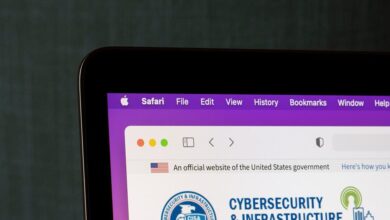
A Rundown on the Top Five Mobile Security Threats
A rundown on the top five mobile security threats is crucial for anyone who relies on their smartphone for work, play, or just staying connected. In today’s hyper-connected world, our phones hold a treasure trove of personal data – from banking details to private photos – making them prime targets for cybercriminals. This post dives into the biggest threats facing mobile users, offering practical tips to help you stay safe and secure in the digital jungle.
We’ll explore everything from sneaky malware and phishing scams to the dangers lurking on public Wi-Fi and the vulnerabilities hidden within seemingly harmless apps. Understanding these threats is the first step toward protecting yourself, and I’m here to guide you through it all with clear explanations and actionable advice. Get ready to level up your mobile security game!
Malware and Viruses: A Rundown On The Top Five Mobile Security Threats
Mobile malware is a significant threat to the security of smartphones and tablets. These malicious software programs can steal data, damage your device, or even use your phone to participate in criminal activities. Understanding the different types of mobile malware and how they infect devices is crucial for effective protection.
Types of Mobile Malware and Infection Methods
Mobile malware manifests in various forms, each with its unique infection method. Some common types include spyware, ransomware, Trojans, adware, and SMS Trojans. Spyware secretly monitors user activity, collecting sensitive information like contacts, location data, and browsing history. Ransomware encrypts files, demanding a ransom for their release. Trojans disguise themselves as legitimate apps, gaining access to the device to perform malicious actions.
Adware displays unwanted advertisements, often consuming significant battery life and data. SMS Trojans exploit messaging services to send spam messages or subscribe users to premium services without their consent. Infection often occurs through downloading apps from untrusted sources, clicking on malicious links in phishing emails or text messages, or visiting compromised websites. Poorly secured Wi-Fi networks also present a vulnerability.
Impact of Malware Families on Mobile Devices
The impact of mobile malware varies depending on the type of malware and its capabilities. For example, spyware can lead to identity theft and financial fraud, while ransomware can render a device unusable until the ransom is paid. Adware can severely impact battery life and data usage, while SMS Trojans can result in unexpected charges and spread malware to other contacts.
In severe cases, some malware can even allow remote access to a device, giving attackers complete control. The financial and personal consequences can be devastating. For instance, a ransomware attack could lead to the loss of irreplaceable photos or business documents, while spyware could expose sensitive financial details, leading to significant financial losses.
Effective Anti-Malware Strategies for Mobile Users
Protecting your mobile device from malware requires a multi-layered approach. First and foremost, download apps only from official app stores like Google Play or the Apple App Store. These stores employ vetting processes to identify and remove malicious applications. Regularly update your operating system and apps to patch security vulnerabilities. Be cautious when clicking on links in emails or text messages, and avoid visiting suspicious websites.
Enable strong passwords and two-factor authentication whenever possible. Consider using a reputable mobile security app that offers real-time protection against malware and other threats. Regularly back up your data to a secure cloud service or external storage to mitigate the impact of ransomware or data loss. Educate yourself and your family about mobile security threats to stay informed and proactive.
Comparison of Common Mobile Malware Types
| Malware Type | Symptoms | Mitigation Techniques | Example |
|---|---|---|---|
| Spyware | Unexpected data usage, unexplained battery drain, strange app permissions. | Install reputable antivirus software, review app permissions, be cautious of unknown apps. | A hidden app constantly tracking location and sending data to a remote server. |
| Ransomware | Files encrypted, ransom demand displayed, inability to access data. | Regular backups, avoid suspicious links, use strong passwords, install reputable antivirus software. | Files are encrypted, a ransom note demands payment in cryptocurrency for decryption. |
| Trojan | Unexpected behavior, slow performance, unauthorized app installations. | Only download apps from trusted sources, review app permissions carefully, use a strong antivirus. | An app disguised as a game that secretly installs other malicious software. |
| Adware | Excessive pop-up ads, increased data usage, slow performance. | Uninstall suspicious apps, use an ad blocker, be cautious of free apps with excessive ads. | A seemingly harmless flashlight app that displays intrusive ads. |
| SMS Trojan | Unexplained premium SMS charges, unsolicited messages sent from your phone. | Be wary of suspicious text messages, review your phone bill regularly, use a strong security app. | An app that sends premium rate SMS messages without user knowledge. |
Phishing and Social Engineering
Phishing and social engineering attacks represent a significant threat to mobile users, leveraging psychological manipulation and technical trickery to steal sensitive information or install malware. These attacks are particularly effective on mobile devices because of their portability and the often-relaxed security measures users employ compared to desktop computers. The constant connectivity and the prevalence of mobile banking and shopping apps make mobile devices prime targets for these attacks.
Mobile phishing employs various techniques to deceive users. These range from cleverly disguised SMS messages (smishing) and emails (phishing) that mimic legitimate organizations to fake login pages for popular apps or websites. Attackers often exploit current events or create a sense of urgency to pressure users into acting quickly without thinking critically. For example, a message might claim to be from a bank, warning of a compromised account and urging the recipient to click a link to verify their details.
The link, of course, leads to a malicious website designed to capture login credentials and other personal information.
Common Phishing Techniques Targeting Mobile Users
The methods used in mobile phishing are constantly evolving, but some common tactics remain consistent. These include the use of shortened URLs, which mask the true destination of a link; spoofed phone numbers that appear to be from trusted sources; and the use of convincing visuals and branding to mimic legitimate apps or websites. Attackers may also leverage social media platforms to spread their malicious links or messages, taking advantage of the trust users have in their social networks.
Examples of Sophisticated Social Engineering Attacks Targeting Mobile Devices
Sophisticated attacks often go beyond simple phishing emails. For instance, an attacker might gain access to a user’s social media account and use that information to craft a personalized phishing message, making it appear even more legitimate. Another tactic involves creating fake mobile apps that mimic legitimate ones, often found on unofficial app stores. These fake apps can contain malware or steal data directly from the device.
In some cases, attackers might use pretexting, pretending to be a technical support representative or a member of a trusted organization, to gain access to the user’s device or personal information. A particularly concerning example is the use of “vishing,” which involves using voice calls to trick users into revealing sensitive information.
The Psychology Behind Successful Phishing and Social Engineering Scams, A rundown on the top five mobile security threats
The success of these attacks hinges on exploiting human psychology. Attackers leverage emotions such as fear, greed, and urgency to manipulate users into making impulsive decisions. The sense of urgency created by a time-sensitive warning or a limited-time offer often prevents users from taking the time to verify the authenticity of the message or link. Trust in authority figures is also exploited, as users are more likely to comply with requests from someone they perceive as being in a position of authority.
Finally, the attacker’s ability to personalize the message, using information gleaned from social media or other sources, increases the likelihood of success.
Training Module: Identifying and Avoiding Phishing Attempts on Mobile Devices
Protecting yourself from phishing and social engineering attacks requires vigilance and awareness. Here’s a short training module outlining key steps:
- Verify the sender: Always check the sender’s email address, phone number, or social media profile for inconsistencies or suspicious details. Be wary of unexpected communications.
- Inspect links carefully: Hover over links (if possible) before clicking to see the actual URL. Look for misspellings or unusual characters in the URL. Avoid clicking shortened URLs.
- Beware of urgency: Legitimate organizations rarely create a sense of panic or urgency. Take your time and verify any requests that seem suspicious.
- Don’t provide personal information unsolicited: Never share sensitive information like passwords, credit card details, or social security numbers in response to unsolicited emails, texts, or calls.
- Use strong passwords and multi-factor authentication: Strong, unique passwords for each account, combined with multi-factor authentication, significantly reduce the risk of unauthorized access.
- Keep your software updated: Regularly update your operating system and apps to patch security vulnerabilities.
- Download apps only from official app stores: Avoid downloading apps from unofficial sources, as these often contain malware.
- Report suspicious activity: If you suspect a phishing attempt, report it to the appropriate authorities or the organization the message is supposedly from.
Public Wi-Fi Risks
Public Wi-Fi networks, while convenient, present significant security vulnerabilities for mobile devices. The open and often unsecured nature of these networks makes them attractive targets for cybercriminals, exposing your personal data to various threats. Understanding these risks and implementing appropriate security measures is crucial for protecting your privacy and online safety.The risks associated with connecting to unsecured or malicious Wi-Fi hotspots are numerous and potentially severe.
Because these networks typically lack encryption, your internet traffic can be intercepted by anyone on the same network. This means sensitive information like passwords, banking details, and personal communications are easily accessible to malicious actors. Furthermore, some hotspots might be deliberately set up to mimic legitimate networks, luring unsuspecting users into a trap where malware can be easily installed on their devices.
This is often referred to as a “man-in-the-middle” attack.
Security Measures for Public Wi-Fi Usage
Using public Wi-Fi responsibly requires a multi-faceted approach. It’s not enough to simply connect; you must actively protect your device and data. Failing to do so leaves you vulnerable to a wide range of cyber threats.
- Avoid sensitive transactions: Refrain from accessing online banking, shopping, or other sensitive accounts while connected to public Wi-Fi. The risk of data interception is too high.
- Enable a VPN: A Virtual Private Network (VPN) encrypts your internet traffic, making it much harder for others to intercept your data. Think of it as creating a secure tunnel for your information.
- Check the network name carefully: Be wary of networks with unusual names or those that don’t clearly identify the location. Malicious hotspots often mimic legitimate network names to trick users.
- Turn off file sharing: Disable file sharing features on your device to prevent unauthorized access to your files.
- Keep your software updated: Ensure your operating system and apps are up-to-date with the latest security patches. This helps protect against known vulnerabilities.
- Enable two-factor authentication (2FA): Whenever possible, enable 2FA for your online accounts. This adds an extra layer of security, even if your password is compromised.
- Use a strong password: Employ a strong, unique password for your Wi-Fi network and all your online accounts. Avoid easily guessable passwords.
- Be cautious of public Wi-Fi in sensitive locations: Avoid using public Wi-Fi in locations like airports or cafes where the risk of malicious hotspots is higher. If you must use it, exercise extra caution.
App Vulnerabilities

The seemingly innocuous act of downloading an app can expose your mobile device to a range of security threats. While app stores strive to maintain a safe environment, vulnerabilities can still slip through, highlighting the importance of understanding the risks associated with app usage. This section delves into the potential dangers lurking within apps, regardless of their origin or perceived legitimacy.
Many vulnerabilities stem from poorly coded apps, inadequate security practices during development, or malicious intent. These flaws can compromise your personal data, financial information, and even device control. The source of the app plays a significant role in the risk level, with unofficial app stores posing a considerably higher threat.
Risks of Downloading Apps from Unofficial App Stores
Unofficial app stores, often found outside of the official Google Play Store or Apple App Store, lack the rigorous security checks and vetting processes employed by their official counterparts. This significantly increases the risk of downloading malware-laden or compromised apps. These apps may contain hidden malicious code designed to steal your data, track your activities, or even take control of your device.
The lack of oversight and verification makes these sources a breeding ground for sophisticated attacks. Furthermore, these apps often lack regular updates, leaving them vulnerable to newly discovered exploits.
So, I’ve been diving deep into a rundown on the top five mobile security threats lately – it’s a scary world out there! Building secure apps is crucial, which is why I also checked out this insightful article on domino app dev, the low-code and pro-code future , as understanding development approaches is key to mitigating those threats.
Back to those top five threats though – malware, phishing, and insecure APIs are definitely top of my list right now.
Vulnerabilities Within Seemingly Legitimate Mobile Apps
Even apps downloaded from official app stores can contain vulnerabilities. These can range from simple coding errors that expose sensitive data to more sophisticated attacks involving data breaches and malware injection. For example, a seemingly harmless game might secretly access your contacts or location data without your explicit permission. Another example is an app that fails to properly encrypt sensitive information, leaving it vulnerable to interception.
These vulnerabilities are often exploited by attackers to gain unauthorized access to your device or data.
Comparison of Security Features: iOS vs. Android
iOS and Android employ different security models, leading to varying levels of protection against app vulnerabilities. iOS, with its stricter app review process and sandboxed environment, generally offers a higher level of security. Android, while increasingly secure, historically has had a more open approach, allowing for greater flexibility but potentially increased vulnerability. However, both platforms have evolved significantly in their security features, and responsible app usage remains key regardless of the operating system.
Android’s open-source nature allows for community scrutiny and faster patch deployment in some cases, which can be an advantage in addressing vulnerabilities.
Common App Vulnerabilities and Their Potential Consequences
| Vulnerability Type | Description | Potential Consequences | Mitigation Strategies |
|---|---|---|---|
| Insecure Data Storage | Sensitive data (passwords, financial info) stored unencrypted. | Data theft, identity theft, financial loss. | Use apps with strong encryption; review app permissions. |
| Insufficient Authorization | App requests excessive permissions (access to contacts, location, etc.). | Privacy violation, data leakage, tracking. | Carefully review requested permissions before installation. |
| Cross-Site Scripting (XSS) | Malicious scripts injected into the app, potentially stealing data. | Data theft, session hijacking, malware infection. | Regular app updates, use reputable app stores. |
| Broken Authentication | Weak or easily bypassed authentication mechanisms. | Unauthorized access to user accounts and data. | Use strong passwords, enable two-factor authentication. |
Data Breaches and Privacy Concerns

Mobile devices, while incredibly convenient, are increasingly becoming prime targets for data breaches. Their portability and constant connectivity make them vulnerable to a range of attacks, exposing sensitive personal information like financial details, health records, and even location data. The consequences of such breaches can be severe, ranging from identity theft and financial loss to reputational damage and emotional distress.Data breaches targeting mobile devices often leverage vulnerabilities in operating systems, apps, or network security.
Hackers might use malware to steal data directly from a device, exploit weaknesses in public Wi-Fi networks to intercept communications, or engage in phishing attacks to trick users into revealing their credentials. The sheer volume of personal data stored on our phones makes them highly attractive targets for malicious actors.
High-Profile Mobile Data Breaches and Their Impact
Several high-profile data breaches have highlighted the vulnerability of mobile devices. For example, the 2017 Equifax breach, while not solely focused on mobile devices, exposed sensitive personal information of millions, some of which was likely accessed via mobile apps or compromised accounts. The impact included identity theft, credit fraud, and significant financial losses for affected individuals. Similarly, breaches targeting healthcare apps have resulted in the exposure of protected health information (PHI), leading to legal repercussions and reputational damage for the companies involved.
These events underscore the need for robust security measures to protect mobile data.
Strong Passwords and Multi-Factor Authentication
Employing strong, unique passwords for each online account is crucial in mitigating the risk of data breaches. A strong password is long, complex, and incorporates a mix of uppercase and lowercase letters, numbers, and symbols. However, even strong passwords can be compromised. Multi-factor authentication (MFA) adds an extra layer of security by requiring users to verify their identity through multiple methods, such as a password and a one-time code sent to their phone or email.
This significantly reduces the likelihood of unauthorized access, even if a password is stolen. For example, using MFA on banking apps prevents unauthorized access even if someone obtains your password.
Protecting Personal Data on Mobile Devices
Protecting your personal data on mobile devices requires a proactive and multi-layered approach. Consider the following steps:
- Keep your software updated: Regularly update your operating system and apps to patch security vulnerabilities.
- Use strong, unique passwords and MFA: Employ strong passwords and enable MFA wherever possible.
- Be cautious of public Wi-Fi: Avoid accessing sensitive information on public Wi-Fi networks, or use a VPN for added security.
- Download apps from reputable sources: Only download apps from official app stores to minimize the risk of malware.
- Enable device encryption: Encrypt your device to protect your data if it’s lost or stolen.
- Regularly review app permissions: Check and limit the permissions granted to your apps to prevent unauthorized access to your data.
- Be wary of phishing attempts: Do not click on suspicious links or open attachments from unknown senders.
- Use a reputable mobile security app: Consider using a mobile security app that provides features like malware scanning and anti-theft protection.
Ending Remarks
Protecting your mobile device isn’t about being paranoid; it’s about being proactive. By understanding the top five mobile security threats – malware, phishing, public Wi-Fi risks, app vulnerabilities, and data breaches – and implementing the simple yet effective strategies discussed, you can significantly reduce your risk of becoming a victim. Remember, a little awareness and vigilance go a long way in keeping your digital life safe and sound.
Stay informed, stay safe, and keep those cybercriminals at bay!
Question Bank
What is the best antivirus app for my phone?
There’s no single “best” app, as effectiveness varies by device and operating system. Research reputable options and read reviews before choosing one. Look for apps with features like real-time protection, malware scanning, and anti-phishing capabilities.
How can I spot a phishing text message?
Phishing texts often contain urgent requests, suspicious links, or grammatical errors. Never click links from unknown numbers and always verify requests directly with the company supposedly contacting you.
Is using a VPN on public Wi-Fi always necessary?
While a VPN adds an extra layer of security, it’s not always strictly necessary. However, if you’re accessing sensitive information on public Wi-Fi, a VPN is highly recommended to encrypt your data.
How often should I update my apps?
Update your apps regularly! Updates often include security patches that fix vulnerabilities, making your device less susceptible to attacks.





